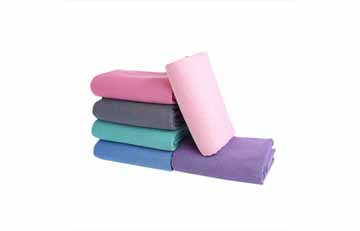What Is a High-Quality Microfiber Towel?
Are all microfiber towels the same? No, there's a difference between a good toilet paper and a less good one. This can be based on a number of factors. There are three things you really need to consider when buying a microfiber towel:
How dry is it?
How much dust does it absorb?
How long will it last?
So, how do you know if you have all three types of towels? Microfiber towel suppliers will tell you.
High-quality microfiber towels will absorb the spill rather than push it to the surface. For many reasons, microfibers are more absorbent than cotton. Having said that, not all microfiber towels are created equal! High-quality towels should be better than low-quality towels to dry and clean up spills more quickly. So, take a water test to see if your microfiber towel is absorbent.
1)Pour water on a smooth surface
2)Place a microfiber cleaning towel on the surface and slide it slowly toward the puddle
3)Observe how the towel interacts with the water. Does it: suck up water like a vacuum cleaner, push it away, or something in between?
4)Does it suck on the towel quickly?
If your towel pushes water away, it is not very absorbent. You need a towel that acts like a vacuum, sucks up the water, and then sucks the wick through the towel. These are signs of a highly absorbent microfiber towel. Make sure your microfiber towels have a polyester/polyamide ratio of 80/20 or 70/30. There is much debate as to which of these mixtures is better. Some people say that one is better for washing and the other is better for drying, while others say there is no difference at all. Of course, as you'll soon discover, there are other factors that can also affect quality. No matter where you stand arguing, everyone agrees that your microfiber towel must fall somewhere between these ratios. Be sure to avoid using 100% polyester microfiber towels.
High-quality microfiber towels are easy to pick up and stick to dust. Make sure the microfiber towels have a "grip" feel. The more "feel" your towel has, the more dirt, dirt, water, and even bacteria it absorbs! Don't worry, the feeling of tightness won't take away from the softness of the fabric, so you don't have to worry about scratching anything delicate. So, here's how you do touch testing:
1)Put your hand on the towel and ask yourself the following questions.
2)Is the material soft?
3)Would you use it in car finishes?
4)Will the material caught the blemish on the skin and be caught by you?
If toweling is grasped by the hand, it is made of microfiber division. High-quality fabrics have undergone a splitting process that makes the cross-section of the fiber look like an asterisk. The process leaves space for your clothes to pick up dirt and absorb liquid. If your cloth doesn't crack, it won't clean better than a cotton towel. Another factor that affects how clean your towel is is the size of each fiber. The smaller the fiber, the more it absorbs. The unit of ultrafine fiber is a denier or the diameter of each fiber. By definition, ultrafine fibers must be less than 1 denier, equal to 10 microns. The cleanliness of high-quality microfiber towels is usually less than 0.5 denier. This makes it small enough to pick up all kinds of bacteria, bacteria, and microbes!

The durability of a microfiber towel is measured by its thickness, which means it will last more times and be much less likely to wear out or unravel. Properly maintained microfiber towels should last hundreds of washes!
The heavier a microfiber towel is, the more microfiber it has.